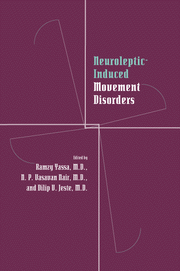Book contents
- Frontmatter
- Contents
- Contributors
- Preface
- Part I Historical perspective
- Part II Clinical aspects of tardive dyskinesia
- Part III Mechanisms underlying tardive dyskinesia
- Part IV Measurement of tardive dyskinesia
- Part V Tardive dyskinesia in different populations
- Part VI Other neuroleptic-induced movement disorders
- Part VII Treatment of tardive dyskinesia
- 28 Development of novel antipsychotic drugs with reduced extrapyramidal side effects
- 29 GABAergic treatments for tardive dyskinesia
- 30 Using biofeedback to train suppression of the oral-lingual movements of tardive dyskinesia
- Index
30 - Using biofeedback to train suppression of the oral-lingual movements of tardive dyskinesia
from Part VII - Treatment of tardive dyskinesia
Published online by Cambridge University Press: 09 October 2009
- Frontmatter
- Contents
- Contributors
- Preface
- Part I Historical perspective
- Part II Clinical aspects of tardive dyskinesia
- Part III Mechanisms underlying tardive dyskinesia
- Part IV Measurement of tardive dyskinesia
- Part V Tardive dyskinesia in different populations
- Part VI Other neuroleptic-induced movement disorders
- Part VII Treatment of tardive dyskinesia
- 28 Development of novel antipsychotic drugs with reduced extrapyramidal side effects
- 29 GABAergic treatments for tardive dyskinesia
- 30 Using biofeedback to train suppression of the oral-lingual movements of tardive dyskinesia
- Index
Summary
The involuntary movement disorder known as tardive dyskinesia typically occurs after long-term administration of neuroleptic drugs. It is most commonly manifested as oral-buccal-lingual movements that are distinct in their manifestation, often including tongue protrusion, grimacing, masticatory movements, and, at times, choreoathetoid movements of the trunk and limbs (Tarsy & Baldessarini, 1977; American Psychiatric Association, 1980; Granacher, 1981; Smith & Kane, 1982; DeVeaugh-Geiss, 1982; Wexler, 1984; Barnes, 1987; Yagi & Itoh, 1987). It is recommended that neuroleptics be withdrawn from patients with tardive dyskinesia if their clinical conditions permit. Although initially neuroleptic withdrawal may exacerbate the abnormal movements, many patients experience remission of abnormal movements after several months. But in many cases the patients' psychiatric conditions will preclude discontinuation of neuroleptics. Indeed, the dyskinesia itself may be severe enough to require neuroleptic medication. The current clinical wisdom that drugs that produce tardive dyskinesia can also suppress it, and vice versa (Jus, Jus, & Fontaine, 1979), is consistent with the dopaminesupersensitivity hypothesis. Tardive dyskinesia appears to be produced by neuroleptic medication, on the one hand, and is often treated with neuroleptic medication, on the other. This relationship of pharmacologic intervention as both cause and treatment argues for an investigation of possible nonpharmacologic treatments for tardive dyskinesia, as either alternative or adjunctive treatments for tardive dyskinesia. Nonpharmacologic interventions should have the added benefits of being low in cost and highly unlikely to exacerbate the condition.
Tardive dyskinesia is believed to be coincident with neuroleptic pharmacologic intervention.
- Type
- Chapter
- Information
- Neuroleptic-induced Movement DisordersA Comprehensive Survey, pp. 470 - 483Publisher: Cambridge University PressPrint publication year: 1996



